Shaoduo Gan
Echo: Decoupling Inference and Training for Large-Scale RL Alignment on Heterogeneous Swarms
Aug 07, 2025Abstract:Modern RL-based post-training for large language models (LLMs) co-locate trajectory sampling and policy optimisation on the same GPU cluster, forcing the system to switch between inference and training workloads. This serial context switching violates the single-program-multiple-data (SPMD) assumption underlying today's distributed training systems. We present Echo, the RL system that cleanly decouples these two phases across heterogeneous "inference" and "training" swarms while preserving statistical efficiency. Echo introduces two lightweight synchronization protocols: a sequential pull mode that refreshes sampler weights on every API call for minimal bias, and an asynchronous push-pull mode that streams version-tagged rollouts through a replay buffer to maximise hardware utilisation. Training three representative RL workloads with Qwen3-4B, Qwen2.5-7B and Qwen3-32B on a geographically distributed cluster, Echo matches a fully co-located Verl baseline in convergence speed and final reward while off-loading trajectory generation to commodity edge hardware. These promising results demonstrate that large-scale RL for LLMs could achieve datacentre-grade performance using decentralised, heterogeneous resources.
SqueezeAttention: 2D Management of KV-Cache in LLM Inference via Layer-wise Optimal Budget
Apr 07, 2024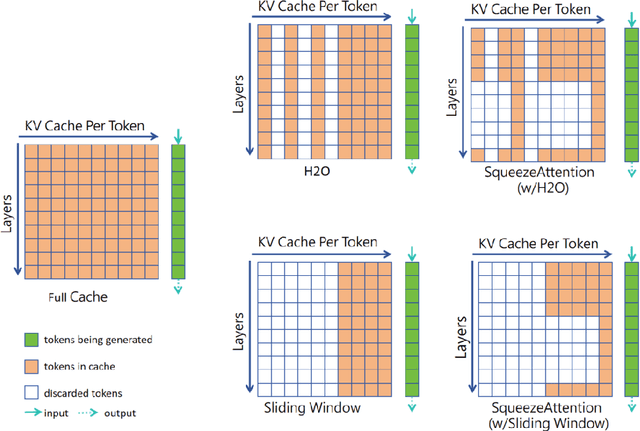

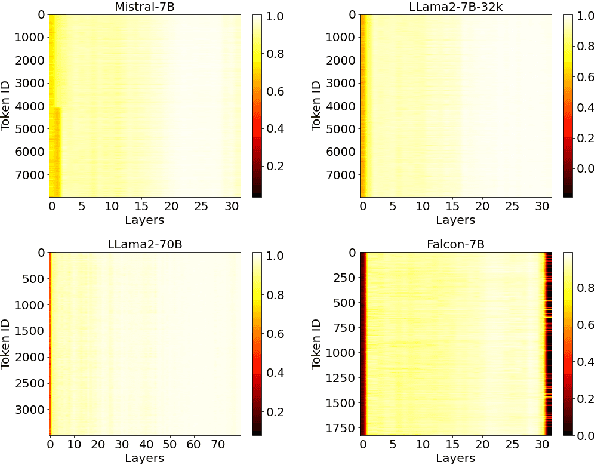

Abstract:Optimizing the Key-Value (KV) cache of the Large Language Model (LLM) has been considered critical to saving the cost of inference. Most of the existing KV-cache compression algorithms attempted to sparsify the sequence of tokens by taking advantage of the different importance of tokens. In this work, we found that by identifying the importance of attention layers, we could optimize the KV-cache jointly from two dimensions. Based on our observations regarding layer-wise importance in inference, we propose SqueezeAttention to precisely optimize the allocation of KV-cache budget among layers on-the-fly and then incorporate three representative token sparsification algorithms to compress the KV-cache for each layer with its very own budget. By optimizing the KV-cache from both sequence's and layer's dimensions, SqueezeAttention achieves around 30% to 70% of the memory reductions and up to 2.2 times of throughput improvements in a wide range of LLMs and benchmarks. The code is available at https://github.com/hetailang/SqueezeAttention.
Few-shot Named Entity Recognition with Entity-level Prototypical Network Enhanced by Dispersedly Distributed Prototypes
Aug 17, 2022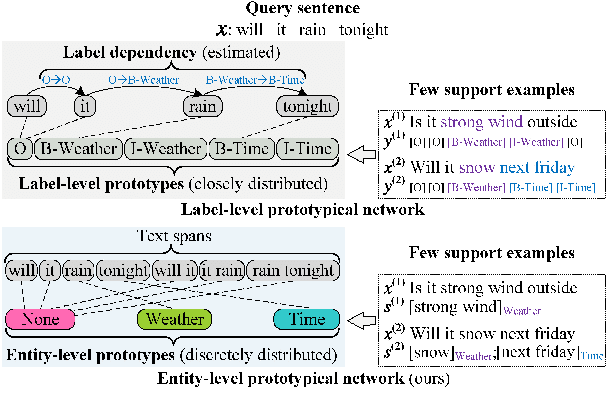

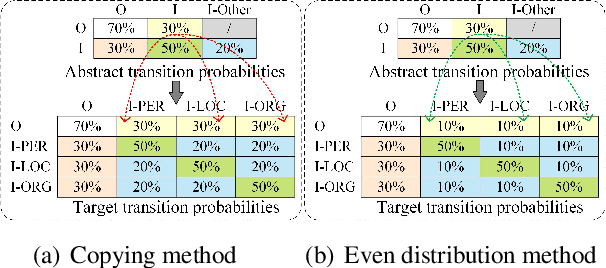

Abstract:Few-shot named entity recognition (NER) enables us to build a NER system for a new domain using very few labeled examples. However, existing prototypical networks for this task suffer from roughly estimated label dependency and closely distributed prototypes, thus often causing misclassifications. To address the above issues, we propose EP-Net, an Entity-level Prototypical Network enhanced by dispersedly distributed prototypes. EP-Net builds entity-level prototypes and considers text spans to be candidate entities, so it no longer requires the label dependency. In addition, EP-Net trains the prototypes from scratch to distribute them dispersedly and aligns spans to prototypes in the embedding space using a space projection. Experimental results on two evaluation tasks and the Few-NERD settings demonstrate that EP-Net consistently outperforms the previous strong models in terms of overall performance. Extensive analyses further validate the effectiveness of EP-Net.
Stochastic Gradient Descent without Full Data Shuffle
Jun 12, 2022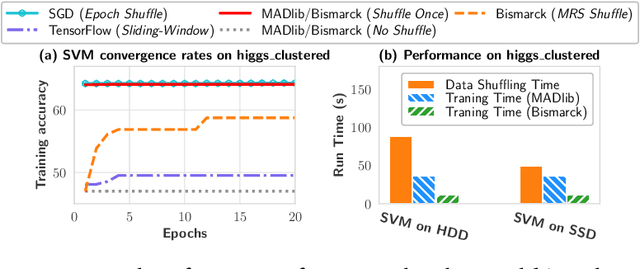


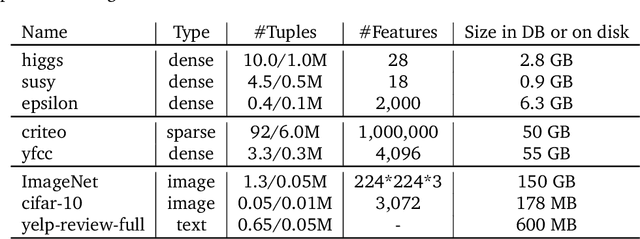
Abstract:Stochastic gradient descent (SGD) is the cornerstone of modern machine learning (ML) systems. Despite its computational efficiency, SGD requires random data access that is inherently inefficient when implemented in systems that rely on block-addressable secondary storage such as HDD and SSD, e.g., TensorFlow/PyTorch and in-DB ML systems over large files. To address this impedance mismatch, various data shuffling strategies have been proposed to balance the convergence rate of SGD (which favors randomness) and its I/O performance (which favors sequential access). In this paper, we first conduct a systematic empirical study on existing data shuffling strategies, which reveals that all existing strategies have room for improvement -- they all suffer in terms of I/O performance or convergence rate. With this in mind, we propose a simple but novel hierarchical data shuffling strategy, CorgiPile. Compared with existing strategies, CorgiPile avoids a full data shuffle while maintaining comparable convergence rate of SGD as if a full shuffle were performed. We provide a non-trivial theoretical analysis of CorgiPile on its convergence behavior. We further integrate CorgiPile into PyTorch by designing new parallel/distributed shuffle operators inside a new CorgiPileDataSet API. We also integrate CorgiPile into PostgreSQL by introducing three new physical operators with optimizations. Our experimental results show that CorgiPile can achieve comparable convergence rate with the full shuffle based SGD for both deep learning and generalized linear models. For deep learning models on ImageNet dataset, CorgiPile is 1.5X faster than PyTorch with full data shuffle. For in-DB ML with linear models, CorgiPile is 1.6X-12.8X faster than two state-of-the-art in-DB ML systems, Apache MADlib and Bismarck, on both HDD and SSD.
FRuDA: Framework for Distributed Adversarial Domain Adaptation
Dec 26, 2021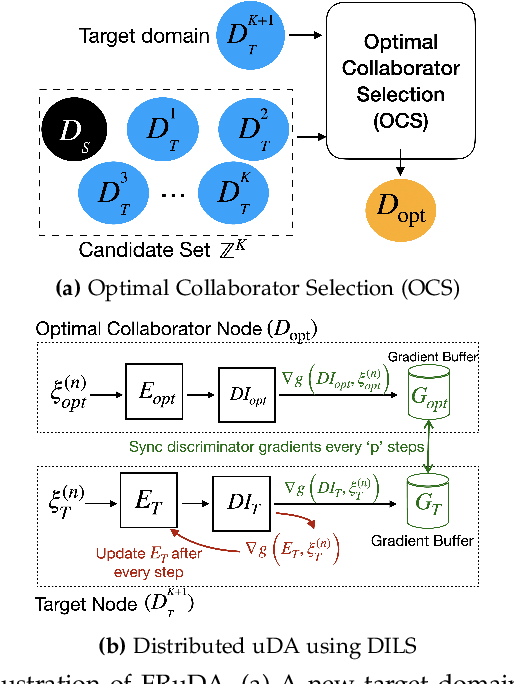
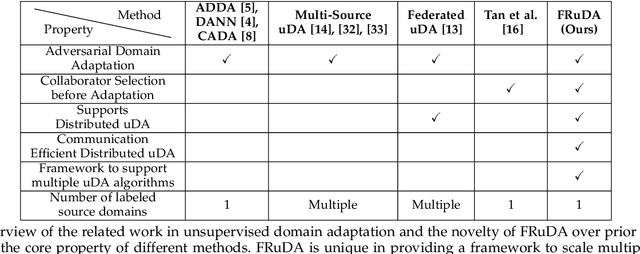
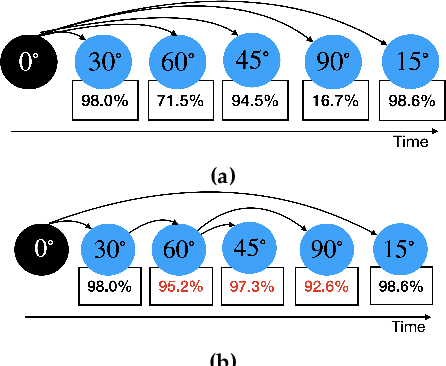

Abstract:Breakthroughs in unsupervised domain adaptation (uDA) can help in adapting models from a label-rich source domain to unlabeled target domains. Despite these advancements, there is a lack of research on how uDA algorithms, particularly those based on adversarial learning, can work in distributed settings. In real-world applications, target domains are often distributed across thousands of devices, and existing adversarial uDA algorithms -- which are centralized in nature -- cannot be applied in these settings. To solve this important problem, we introduce FRuDA: an end-to-end framework for distributed adversarial uDA. Through a careful analysis of the uDA literature, we identify the design goals for a distributed uDA system and propose two novel algorithms to increase adaptation accuracy and training efficiency of adversarial uDA in distributed settings. Our evaluation of FRuDA with five image and speech datasets show that it can boost target domain accuracy by up to 50% and improve the training efficiency of adversarial uDA by at least 11 times.
BAGUA: Scaling up Distributed Learning with System Relaxations
Jul 12, 2021
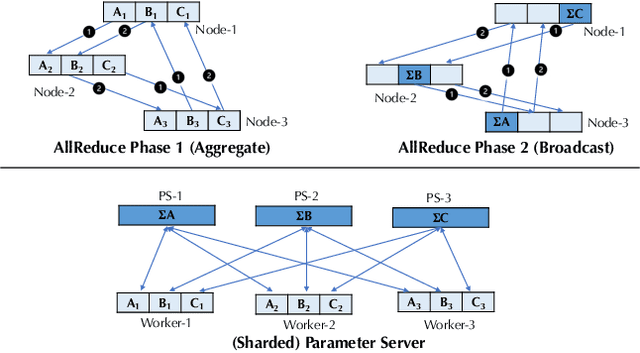
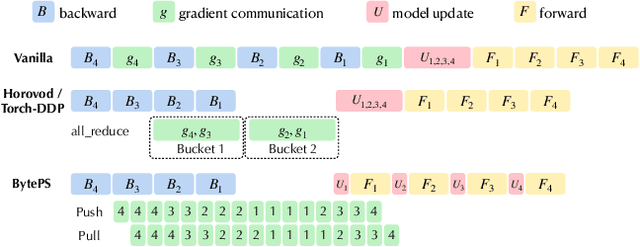

Abstract:Recent years have witnessed a growing list of systems for distributed data-parallel training. Existing systems largely fit into two paradigms, i.e., parameter server and MPI-style collective operations. On the algorithmic side, researchers have proposed a wide range of techniques to lower the communication via system relaxations: quantization, decentralization, and communication delay. However, most, if not all, existing systems only rely on standard synchronous and asynchronous stochastic gradient (SG) based optimization, therefore, cannot take advantage of all possible optimizations that the machine learning community has been developing recently. Given this emerging gap between the current landscapes of systems and theory, we build BAGUA, a communication framework whose design goal is to provide a system abstraction that is both flexible and modular to support state-of-the-art system relaxation techniques of distributed training. Powered by the new system design, BAGUA has a great ability to implement and extend various state-of-the-art distributed learning algorithms. In a production cluster with up to 16 machines (128 GPUs), BAGUA can outperform PyTorch-DDP, Horovod and BytePS in the end-to-end training time by a significant margin (up to 1.95 times) across a diverse range of tasks. Moreover, we conduct a rigorous tradeoff exploration showing that different algorithms and system relaxations achieve the best performance over different network conditions.
Towards Demystifying Serverless Machine Learning Training
May 17, 2021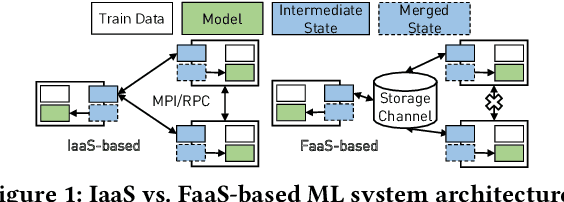

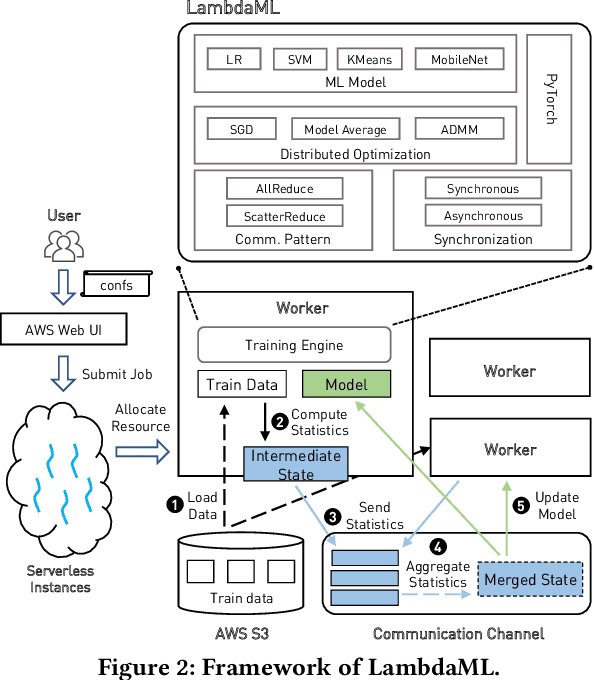
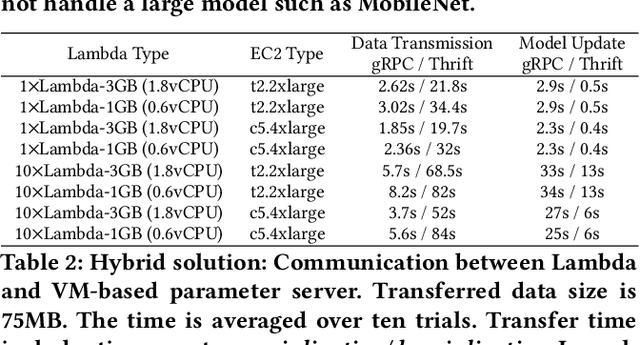
Abstract:The appeal of serverless (FaaS) has triggered a growing interest on how to use it in data-intensive applications such as ETL, query processing, or machine learning (ML). Several systems exist for training large-scale ML models on top of serverless infrastructures (e.g., AWS Lambda) but with inconclusive results in terms of their performance and relative advantage over "serverful" infrastructures (IaaS). In this paper we present a systematic, comparative study of distributed ML training over FaaS and IaaS. We present a design space covering design choices such as optimization algorithms and synchronization protocols, and implement a platform, LambdaML, that enables a fair comparison between FaaS and IaaS. We present experimental results using LambdaML, and further develop an analytic model to capture cost/performance tradeoffs that must be considered when opting for a serverless infrastructure. Our results indicate that ML training pays off in serverless only for models with efficient (i.e., reduced) communication and that quickly converge. In general, FaaS can be much faster but it is never significantly cheaper than IaaS.
1-bit Adam: Communication Efficient Large-Scale Training with Adam's Convergence Speed
Feb 04, 2021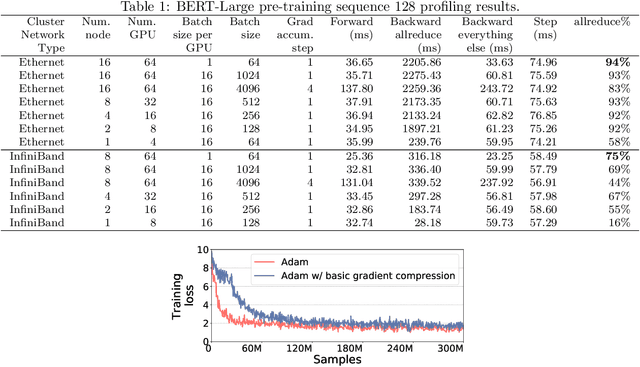
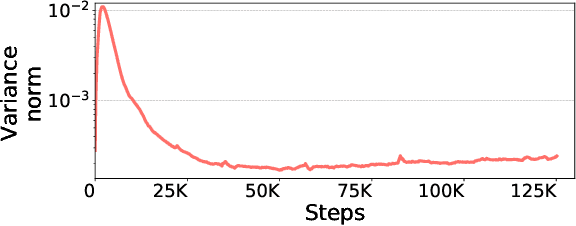
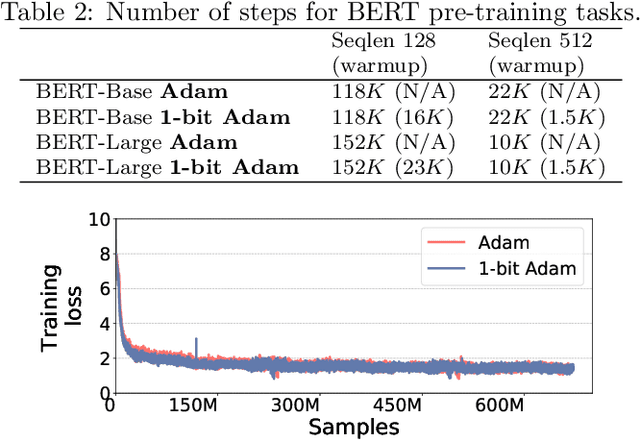

Abstract:Scalable training of large models (like BERT and GPT-3) requires careful optimization rooted in model design, architecture, and system capabilities. From a system standpoint, communication has become a major bottleneck, especially on commodity systems with standard TCP interconnects that offer limited network bandwidth. Communication compression is an important technique to reduce training time on such systems. One of the most effective methods is error-compensated compression, which offers robust convergence speed even under 1-bit compression. However, state-of-the-art error compensation techniques only work with basic optimizers like SGD and momentum SGD, which are linearly dependent on the gradients. They do not work with non-linear gradient-based optimizers like Adam, which offer state-of-the-art convergence efficiency and accuracy for models like BERT. In this paper, we propose 1-bit Adam that reduces the communication volume by up to $5\times$, offers much better scalability, and provides the same convergence speed as uncompressed Adam. Our key finding is that Adam's variance (non-linear term) becomes stable (after a warmup phase) and can be used as a fixed precondition for the rest of the training (compression phase). Experiments on up to 256 GPUs show that 1-bit Adam enables up to $3.3\times$ higher throughput for BERT-Large pre-training and up to $2.9\times$ higher throughput for SQuAD fine-tuning. In addition, we provide theoretical analysis for our proposed work.
APMSqueeze: A Communication Efficient Adam-Preconditioned Momentum SGD Algorithm
Aug 28, 2020
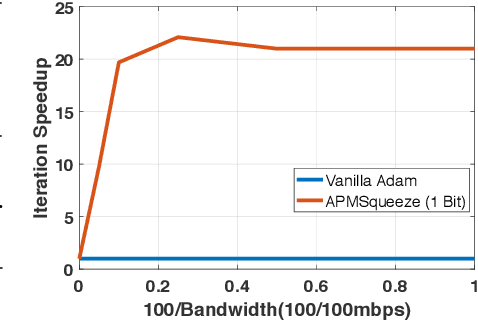
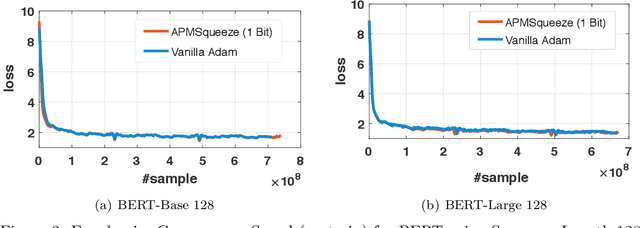
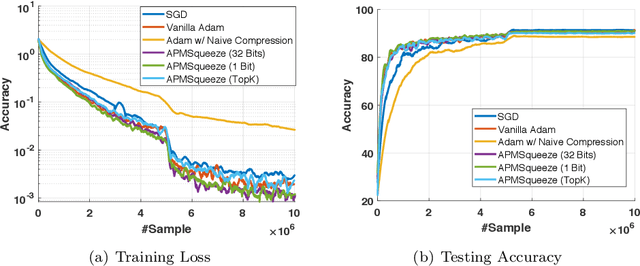
Abstract:Adam is the important optimization algorithm to guarantee efficiency and accuracy for training many important tasks such as BERT and ImageNet. However, Adam is generally not compatible with information (gradient) compression technology. Therefore, the communication usually becomes the bottleneck for parallelizing Adam. In this paper, we propose a communication efficient {\bf A}DAM {\bf p}reconditioned {\bf M}omentum SGD algorithm-- named APMSqueeze-- through an error compensated method compressing gradients. The proposed algorithm achieves a similar convergence efficiency to Adam in term of epochs, but significantly reduces the running time per epoch. In terms of end-to-end performance (including the full-precision pre-condition step), APMSqueeze is able to provide {sometimes by up to $2-10\times$ speed-up depending on network bandwidth.} We also conduct theoretical analysis on the convergence and efficiency.
Communication Compression for Decentralized Training
Sep 27, 2018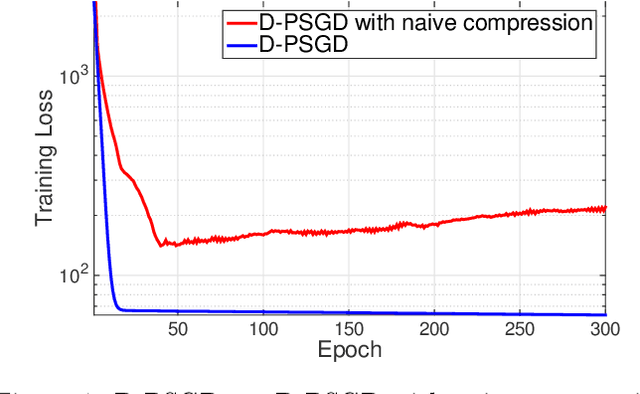


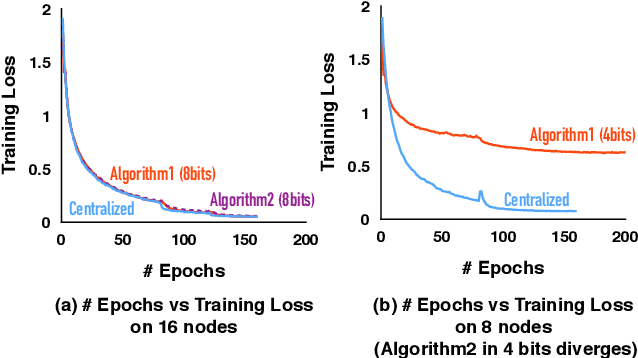
Abstract:Optimizing distributed learning systems is an art of balancing between computation and communication. There have been two lines of research that try to deal with slower networks: {\em communication compression} for low bandwidth networks, and {\em decentralization} for high latency networks. In this paper, We explore a natural question: {\em can the combination of both techniques lead to a system that is robust to both bandwidth and latency?} Although the system implication of such combination is trivial, the underlying theoretical principle and algorithm design is challenging: unlike centralized algorithms, simply compressing exchanged information, even in an unbiased stochastic way, within the decentralized network would accumulate the error and fail to converge. In this paper, we develop a framework of compressed, decentralized training and propose two different strategies, which we call {\em extrapolation compression} and {\em difference compression}. We analyze both algorithms and prove both converge at the rate of $O(1/\sqrt{nT})$ where $n$ is the number of workers and $T$ is the number of iterations, matching the convergence rate for full precision, centralized training. We validate our algorithms and find that our proposed algorithm outperforms the best of merely decentralized and merely quantized algorithm significantly for networks with {\em both} high latency and low bandwidth.
 Add to Chrome
Add to Chrome Add to Firefox
Add to Firefox Add to Edge
Add to Edge